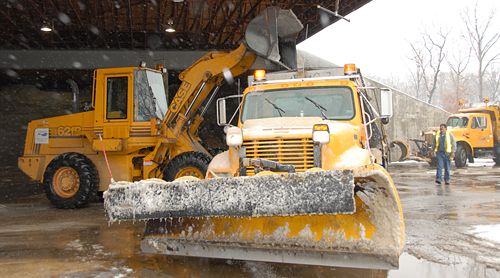Difference between revisions of "133.1 Materials for Snow and Ice Control"
m (article construction) |
m (article construction) |
||
| Line 10: | Line 10: | ||
==133.1.2 Storage== | ==133.1.2 Storage== | ||
| − | Chemicals and stockpiles of treated abrasives are to be stored in a manner to prevent loss of material and prevent damage to state or private property. All bulk salt shall be stored inside covered storage structures. Asphalt pads are to be constructed under and in front of all storage facilities. Mixed materials shall be covered when not in use and between storm events. For additional information, refer to [[127.25 Maintenance Environmental Policies#127.25.8.8 Salt Run-off|Salt Run-off]]. | + | Chemicals and stockpiles of treated abrasives are to be stored in a manner to prevent loss of material and prevent damage to state or private property. All bulk salt shall be stored inside covered storage structures. Asphalt pads are to be constructed under and in front of all storage facilities. Mixed materials shall be covered when not in use and between storm events. For additional information, refer to [[127.25 Maintenance Environmental Policies#127.25.8.8.1 Salt Run-off|Salt Run-off]]. |
:Reason for policy: Prevents loss of material and damage to private property. Most salt runoff damage comes from mixed piles. | :Reason for policy: Prevents loss of material and damage to private property. Most salt runoff damage comes from mixed piles. | ||
Revision as of 13:14, 6 August 2008
Contents
133.1.1 Liquid Chemical
Brine, for both pre-treatment and pre-wetting, is to be made using rock salt (sodium chloride). Liquid Calcium Chloride may be used in extremely cold temperatures when brine is less effective.
- Reasons for policy: Sodium chloride is as effective as calcium chloride at temperatures above 20° F and is less expensive.
- Effective Date: 6/1/99
- Revision Dates: 6/17/03
133.1.2 Storage
Chemicals and stockpiles of treated abrasives are to be stored in a manner to prevent loss of material and prevent damage to state or private property. All bulk salt shall be stored inside covered storage structures. Asphalt pads are to be constructed under and in front of all storage facilities. Mixed materials shall be covered when not in use and between storm events. For additional information, refer to Salt Run-off.
- Reason for policy: Prevents loss of material and damage to private property. Most salt runoff damage comes from mixed piles.
- Effective Date: 6/1/99
- Revision Dates: 6/17/03
133.1.3 Salt Prefill
All salt shall be ordered far enough in advance to ensure that by November 1st , each maintenance lot is storing salt at full capacity.
- Reasons for policy: Assures storage is at capacity at the start of winter season, reduces re-supply problem and maintains MoDOT supplier relations.
- Effective Date: 6/1/99
- Revision Dates: 6/17/03
133.1.4 Salt Replenishment
Districts shall re-order salt as needed under terms of the current contract. If suppliers are no longer able to meet statewide orders, the State Maintenance Engineer will coordinate orders to ensure each district's critical needs are met. For additional information, refer to 133.1.7 Liquidated Damages.
- Reasons for policy: Centralizes reserve salt storage, minimizes weather effects on stored salt, increases salt storage capacity and lowers the cost for salt storage
- Effective Date: 6/1/99
- Revision Dates: 6/17/03
133.1.5 Large Storage Facilities
Storage facilities of 2000 tons or greater capacity shall act as centralized locations for salt, to re-supply buildings in multi-county areas which may include buildings in other districts.
- Reasons for policy: Centralizes reserve salt storage, minimizes weather effects on stored salt, increases salt storage capacity and lowers the cost for salt storage
- Effective Date: 6/1/99
- Revision Dates: 6/17/03
133.1.6 Abrasives
The maximum aggregate size for abrasives shall not exceed 3/8 in. Lead mining chat (within established limits) may be used for general maintenance purposes. See Missouri Standard Specifications for Highway Construction for established lead limits in mining by-product aggregates. For more information, refer to Lead Mining Chat.
- Reasons for policy: Experience has shown that an aggregate size larger than 3/8 in. is ineffective and contributes to broken windshields; mining tailings may contain environmentally unsafe materials.
- Effective Date: 6/1/99
- Revision Dates: 6/17/03
133.1.7 Liquidated Damages
Approval must be received from the State Maintenance Engineer before liquidated damages can be waived. Refer to 133.1.4 Salt Replenishment.
- Reasons for policy: All suppliers must be treated the same; contracts are legal documents to be fulfilled by both parties; unfair treatment can result in loss of qualified bidders.
- Effective Date: 6/1/99
- Revision Dates: 6/17/03
133.1.8 Pre-wetting
Salt and mixed materials shall be pre-wetted with an approved liquid chemical.
- Reasons for policy: Pre-wetting will allow these materials to act on the snow pack or ice more quickly and in the case of abrasives, will enable them to imbed in the snow or ice pack; reduces the bounce and scatter of materials.
- Effective Date: 6/1/99
- Revision Dates: 6/17/03
